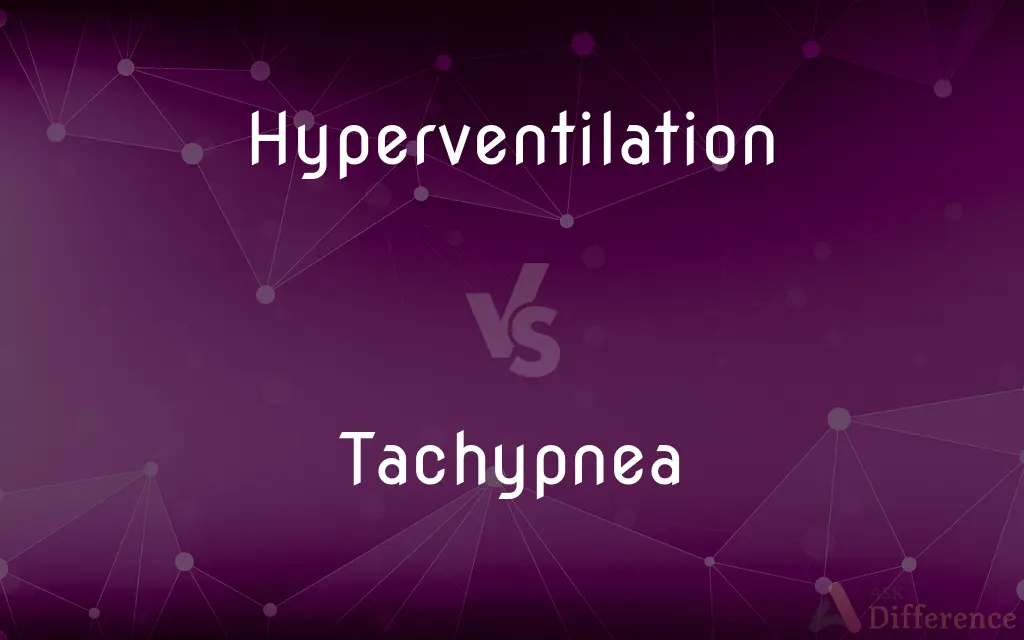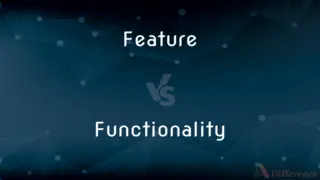Hyperventilation vs. Tachypnea — What's the Difference?
By Tayyaba Rehman & Fiza Rafique — Updated on March 13, 2024
Hyperventilation is the condition of breathing at an abnormally rapid rate, leading to excessive expulsion of carbon dioxide. Tachypnea is an increased respiratory rate, often a symptom of an underlying medical condition without necessarily affecting CO2.

Difference Between Hyperventilation and Tachypnea
Table of Contents
ADVERTISEMENT
Key Differences
Hyperventilation is characterized by rapid or deep breathing that goes beyond the body's metabolic needs, resulting in a decrease in blood carbon dioxide levels (hypocapnia). This can lead to various symptoms, including lightheadedness, tingling in the limbs, and sometimes anxiety or panic attacks. Tachypnea, on the other hand, is simply an increased rate of breathing which can be a normal physiological response to factors like exercise or high altitude, or indicative of medical conditions such as fever, lung diseases, or heart conditions.
The primary distinction between hyperventilation and tachypnea lies in the cause and the physiological effects on the body. Hyperventilation is often triggered by stress, anxiety, or panic disorders, leading to an imbalance in oxygen and carbon dioxide levels. Tachypnea, however, is usually a response to a physiological demand or a symptom of an underlying medical issue, not necessarily accompanied by an imbalance in blood gases.
Treatment for hyperventilation often involves techniques to increase carbon dioxide levels in the blood, such as breathing into a paper bag or using controlled breathing techniques. Tachypnea treatment targets the underlying cause, whether it's addressing fever, infection, chronic lung conditions, or other medical issues.
While hyperventilation can sometimes be controlled through self-regulation or behavioral therapy, especially if anxiety-induced, tachypnea requires medical attention to diagnose and treat the root cause of the increased breathing rate.
Understanding the difference between hyperventilation and tachypnea is crucial for appropriate management, as each has distinct implications for treatment and patient care. Recognizing the signs and seeking appropriate medical evaluation is key in addressing the specific needs related to each condition.
ADVERTISEMENT
Comparison Chart
Definition
Rapid or deep breathing reducing blood CO2 levels.
Increased breathing rate, often due to underlying conditions.
Causes
Often psychological, like stress or panic.
Physiological demand or medical conditions like fever or lung disease.
Symptoms
Lightheadedness, tingling, anxiety.
Rapid breathing; other symptoms depend on the underlying cause.
Effects
Decrease in blood CO2, possibly leading to alkalosis.
May not affect blood gas levels unless related to a respiratory condition.
Treatment
Breathing techniques, managing anxiety.
Addressing the underlying medical condition.
Compare with Definitions
Hyperventilation
Rapid breathing triggered by panic or anxiety.
During the exam, her anxiety led to hyperventilation, making her feel dizzy.
Tachypnea
An increase in breathing rate due to physiological demand or illness.
His rapid respiratory response to the high altitude was a clear sign of tachypnea.
Hyperventilation
The body's rapid breathing response to stress or fear.
The sudden loud noise caused a psychological trigger response, leading to hyperventilation.
Tachypnea
Addressing the root cause of increased respiratory rate.
Treating his chronic lung disease effectively managed his tachypnea.
Hyperventilation
A condition resulting from the excessive loss of CO2 due to hyperventilation.
The prolonged episode of hyperventilation resulted in respiratory alkalosis.
Tachypnea
Increased breathing rate as an indicator of medical issues.
The patient's tachypnea was a symptom of her underlying lung infection.
Hyperventilation
The effect of expelling too much carbon dioxide due to overbreathing.
His hyperventilation during the panic attack drastically reduced his blood CO2 levels.
Tachypnea
The body's adjustment to increased oxygen needs through faster breathing.
Her tachypnea during the intense workout was a physiological demand adaptation.
Hyperventilation
Methods used to normalize breathing and CO2 levels.
She used breathing control techniques to manage her hyperventilation symptoms.
Tachypnea
The body's response to elevated temperature with faster breathing.
The child's fever-induced breathing rate increase was diagnosed as tachypnea.
Hyperventilation
Hyperventilation occurs when the rate or tidal volume of breathing eliminates more carbon dioxide than the body can produce. This leads to hypocapnia, a reduced concentration of carbon dioxide dissolved in the blood.
Tachypnea
Tachypnea, also spelt tachypnoea, is a respiratory rate greater than normal, resulting in abnormally rapid breathing.In adult humans at rest, any respiratory rate of 12–20 per minute is considered clinically normal, with tachypnea being any rate above that. Children have significantly higher resting ventilatory rates, which decline rapidly during the first three years of life and then steadily until around 18 years.
Hyperventilation
Abnormally fast or deep respiration, which results in the loss of carbon dioxide from the blood, thereby causing a fall in blood pressure, tingling of the extremities, and sometimes fainting.
Tachypnea
Rapid breathing.
Hyperventilation
(medicine) the state of breathing faster or deeper than necessary
Tachypnea
Alternative spelling of tachypnoea
Hyperventilation
The act or process of hyperventilating; breathing rapidly and deeply.
Hyperventilation
A condition in which alveolar carbon dioxide concentration is markedly lower than normal, usually due to breathing rapidly and deeply.
Hyperventilation
An increased depth and rate of breathing greater than demanded by the body needs; can cause dizziness and tingling of the fingers and toes and chest pain if continued
Common Curiosities
Is tachypnea always a sign of a serious condition?
While tachypnea can indicate an underlying medical issue, its seriousness varies widely depending on the cause and context.
How do you differentiate between hyperventilation and tachypnea in a clinical setting?
Differentiation involves assessing symptoms, breathing patterns, and potential underlying causes, alongside diagnostic tests to evaluate blood gas levels.
Can hyperventilation be a symptom of a physical health problem?
Yes, while often psychological, hyperventilation can also be triggered by physical conditions that affect breathing or oxygenation.
Is tachypnea more common in certain age groups?
Tachypnea can occur in any age group but may be more commonly recognized in infants and children with respiratory infections or congenital heart disease.
What are the long-term effects of untreated tachypnea?
Untreated tachypnea, depending on the underlying cause, can lead to chronic respiratory issues, decreased oxygen levels, and potential damage to body tissues.
Are there any preventive measures for tachypnea?
Preventive measures include managing chronic conditions effectively, avoiding respiratory irritants, and timely treatment of infections.
Can anxiety cause both hyperventilation and tachypnea?
Anxiety can directly cause hyperventilation and indirectly lead to tachypnea if it results in physiological changes that increase the respiratory rate.
Does hyperventilation affect heart rate?
Hyperventilation can increase heart rate due to the body's response to decreased carbon dioxide levels.
Can children experience both hyperventilation and tachypnea?
Children can experience both conditions, with causes ranging from emotional distress and anxiety to infections and asthma.
Can physical exercise cause tachypnea?
Yes, physical exercise increases metabolic demand, leading to tachypnea as the body attempts to meet the increased need for oxygen.
Is it possible to hyperventilate in your sleep?
Yes, conditions like sleep apnea or panic disorders can lead to episodes of hyperventilation during sleep.
How quickly can hyperventilation be resolved?
Hyperventilation can often be quickly resolved with controlled breathing techniques, especially if it's anxiety-induced.
Can diet influence hyperventilation or tachypnea?
While diet doesn't directly cause these conditions, a balanced diet can support overall health and mitigate factors that might contribute to respiratory issues.
Are hyperventilation and tachypnea treatable at home?
While some mild cases might be managed at home with appropriate techniques or remedies, medical consultation is essential to address underlying causes and prevent complications.
How is tachypnea managed in chronic lung diseases?
In chronic lung diseases, tachypnea management includes treating the underlying disease, using medications like bronchodilators, and sometimes oxygen therapy.
Share Your Discovery

Previous Comparison
Pianola vs. Piano
Next Comparison
Feature vs. FunctionalityAuthor Spotlight
Written by
Tayyaba RehmanTayyaba Rehman is a distinguished writer, currently serving as a primary contributor to askdifference.com. As a researcher in semantics and etymology, Tayyaba's passion for the complexity of languages and their distinctions has found a perfect home on the platform. Tayyaba delves into the intricacies of language, distinguishing between commonly confused words and phrases, thereby providing clarity for readers worldwide.
Co-written by
Fiza RafiqueFiza Rafique is a skilled content writer at AskDifference.com, where she meticulously refines and enhances written pieces. Drawing from her vast editorial expertise, Fiza ensures clarity, accuracy, and precision in every article. Passionate about language, she continually seeks to elevate the quality of content for readers worldwide.














































